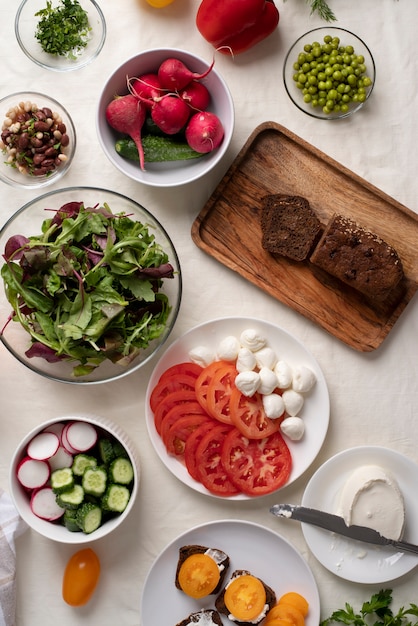What vegetables taste best together?
Choosing the right combination of vegetables can greatly enhance the flavor and enjoyment of any dish. Whether you are cooking a hearty stew, a refreshing salad, or a simple side dish, finding vegetables that complement each other in taste and texture is key. In this article, we will explore some delightful vegetable pairings that are bound to elevate your culinary creations.
Understanding Flavor Profiles
Before we delve into specific vegetable combinations, it’s important to understand the concept of flavor profiles. Each vegetable has its own unique taste and characteristics, which can be further enhanced or balanced by pairing it with the right companion. Some vegetables have bold and earthy flavors, while others are more delicate and subtle.
By considering the taste attributes such as sweetness, bitterness, acidity, and umami, you can create harmonious flavor combinations that will delight your taste buds. Don’t be afraid to experiment and discover your own favorite vegetable pairings!
Classic Combinations
There are several classic vegetable combinations that have stood the test of time and continue to be popular choices in various cuisines. Here are a few timeless pairings:
- Tomatoes and Basil: The sweet acidity of tomatoes pairs beautifully with the fresh and aromatic flavor of basil. This combination is a match made in heaven and is often used in Italian dishes like Caprese salad.
- Carrots, Celery, and Onions: Known as the holy trinity in culinary terms, these three vegetables form the base of many soups, stews, and sauces. The sweetness of carrots, the crispness of celery, and the pungency of onions work together to create depth and complexity in flavors.
- Spinach and Feta: The rich and creamy taste of feta cheese complements the earthy bitterness of spinach. This combination is often used in savory pies, salads, and pasta dishes.
Unconventional Pairings
While classic combinations have their charm, don’t limit yourself to the tried and tested. Sometimes, the most unexpected pairings can yield impressive results. Here are a few unconventional vegetable pairings that might surprise you:
- Beets and Oranges: The sweetness of beets harmonizes with the tangy citrus flavor of oranges. This vibrant combination can bring a burst of freshness to salads or roasted vegetable dishes.
- Cauliflower and Curry: Cauliflower’s mild flavor is a perfect canvas for bold spices like curry. By adding a touch of curry powder, you can transform this humble vegetable into a flavorful and fragrant delight.
- Asparagus and Lemon: The natural bitterness of asparagus is balanced by the zesty acidity of lemon. A squeeze of lemon juice can brighten up the flavors of roasted or grilled asparagus.
“Vegetable pairings can unlock a world of flavors and take your cooking to new heights. Don’t be afraid to experiment and discover your own unique combinations!”
Remember, taste is subjective, and personal preference plays a significant role in determining which vegetables taste best together. Consider the characteristics of each vegetable, experiment with different combinations, and trust your palate to guide you on a culinary adventure filled with delightful flavors.
What Fruits and Veggies Should Not be Mixed Together?
When it comes to creating nutritious meals, combining different fruits and vegetables is a great way to ensure you get a variety of vitamins and minerals. However, not all fruits and veggies are compatible with each other when it comes to digestion. Mixing certain combinations can lead to discomfort, digestive issues, and potentially hinder nutrient absorption. In this article, we’ll explore some combinations that are best avoided.
1. Acidic Fruits with Starchy Vegetables
Mixing acidic fruits such as oranges or grapefruit with starchy vegetables like potatoes or corn can cause fermentation in the stomach, leading to bloating and gas. The reason behind this is that starches require an alkaline environment for digestion, while acids require an acidic environment. The conflicting pH levels can disrupt digestion.
2. Citrus Fruits with Carrots or Tomatoes
Citrus fruits like lemons or limes are highly acidic, and when combined with carrots or tomatoes, which are alkaline, they can alter the pH balance in the stomach. This can result in indigestion, acid reflux, or heartburn.
3. Sweet Fruits with High-Protein Foods
Combining sweet fruits such as bananas or grapes with high-protein foods like nuts or legumes can lead to digestive discomfort. Sweet fruits have a quick digestion time, while proteins take longer to break down. This difference in digestion speed can cause fermentation in the gut, resulting in bloating and gas.
4. Melons with Other Fruits
It’s best to consume melons on their own, without mixing them with other fruits. Melons have a high water content and digest quickly, while other fruits may take longer to break down. Combining melons with other fruits can cause the melon to stay in the stomach for an extended period, leading to fermentation and digestive issues.
To optimize the digestion of fruits and vegetables:
- Avoid combining acidic fruits with starchy vegetables.
- Avoid mixing citrus fruits with alkaline vegetables like carrots or tomatoes.
- Consume sweet fruits separately from high-protein foods.
- Enjoy melons on their own, without combining them with other fruits.
“By being mindful of how we combine fruits and veggies, we can support our digestion and ensure optimal nutrient absorption.”
Although these combinations may not cause harm to everyone, some individuals with sensitive digestive systems may experience discomfort. It’s always a good idea to listen to your body and experiment with different combinations to find what works best for you.
Does Broccoli Go with Ribs?
Introduction
When it comes to enjoying a delicious plate of ribs, many people wonder what side dish best complements this meaty delight. While classic pairings like cornbread or coleslaw often come to mind, have you ever considered adding a healthy vegetable option into the mix? In this article, we explore whether broccoli is a suitable accompaniment for ribs.
The Health Benefits of Broccoli
Broccoli is a nutritious vegetable that offers numerous health benefits. Packed with vitamins A, C, and K, as well as fiber and antioxidants, it is known to support immune function, aid digestion, and contribute to overall wellbeing. Adding broccoli to your meal can help balance out the richness of ribs and provide a burst of essential nutrients.
Flavor Pairings
Despite their stark differences, ribs and broccoli can actually create a harmonious flavor combination when prepared thoughtfully. The smoky and savory flavors of ribs can be complemented by the slightly bitter and earthy taste of broccoli. For an enhanced experience, try grilling or roasting the broccoli with a touch of olive oil, salt, and garlic to bring out its natural flavors.
Recipes Ideas:
- Grilled Broccoli Skewers: Thread broccoli florets onto skewers and grill alongside the ribs. Serve with a drizzle of balsamic glaze for added tanginess.
- Broccoli Slaw: Swap traditional coleslaw for a refreshing broccoli slaw. Thinly slice broccoli stems along with carrots and cabbage, then toss with a zesty dressing.
- Broccoli Stir-Fry: Create a quick stir-fry by combining broccoli florets, your choice of protein, and a flavorful sauce. Serve alongside ribs for a balanced and satisfying meal.
A Word of Caution
While broccoli can be a delicious and nutritious addition to your ribs, it’s important to consider individual preferences and dietary restrictions. If you or your guests have specific dietary requirements or dislikes, always provide alternative side dishes to ensure everyone can enjoy the meal to their liking.
In conclusion, while it may seem unconventional, pairing broccoli with ribs can add both flavor and nutrition to your meal. Don’t be afraid to experiment and combine different tastes and textures to create a memorable dining experience!
Which vegetables are best to roast together?
Introduction
Roasted vegetables are a delicious and nutritious addition to any meal. Not only do they provide a satisfying texture and flavor, but they are also packed with essential vitamins and minerals. When it comes to roasting vegetables, choosing the right combination can take your dish to the next level. In this article, we will explore which vegetables are best to roast together for a tasty and well-balanced meal.
Pairing Vegetables
To create a harmonious blend of flavors and textures, it’s important to select vegetables that complement each other. Here are some popular vegetable pairings for roasting:
- Root vegetables: Potatoes, carrots, parsnips, and sweet potatoes work well together as their earthy flavors complement one another.
- Mediterranean vegetables: Bell peppers, zucchini, eggplant, and onions create a vibrant and flavorful combination.
- Brassicas: Broccoli, cauliflower, and Brussels sprouts make a nutritious trio with complementary tastes.
Tips for Roasting
When roasting vegetables, there are a few tips to keep in mind:
- Cut the vegetables into similar-sized pieces to ensure even cooking.
- Toss the vegetables with olive oil, salt, and pepper before roasting to enhance their flavors.
- Spread the vegetables in a single layer on a baking sheet to promote browning and avoid steaming.
- Roast at a high temperature (around 425°F/220°C) for a caramelized exterior and tender interior.
Roasting Times
The roasting times may vary depending on the type and size of the vegetables. Here’s a general guideline:
| Vegetable | Roasting Time |
|---|---|
| Potatoes | 30-40 minutes |
| Carrots | 20-30 minutes |
| Bell peppers | 15-20 minutes |
| Zucchini | 10-15 minutes |
What Vegetables Should Not be Mixed Together?
When it comes to cooking and meal preparation, knowing which vegetables should not be mixed together is important. Some vegetables have different cooking times or release enzymes that can affect the taste and texture of others. Here are some common vegetables that should not be mixed together:
1. Tomatoes and Cucumbers
Tomatoes and cucumbers are commonly used in salads, but they should not be mixed together. Tomatoes contain enzymes that can cause cucumbers to become soft and mushy.
2. Onions and Potatoes
Onions and potatoes should not be stored together as the onions release gases that can cause potatoes to sprout and spoil more quickly. Keep them separate to extend their shelf life.
3. Leafy Greens and Citrus Fruits
Leafy greens, such as spinach or arugula, and citrus fruits should not be combined in a dish. The acidity in the citrus fruits can cause the greens to wilt and turn bitter.
4. Carrots and Dill
The flavor of carrots and dill do not complement each other well. Carrots have a sweet and earthy taste, while dill has a strong and distinct flavor. Mixing them together may result in an unappetizing combination.
5. Radishes and Brussels Sprouts
Radishes and Brussels sprouts should be avoided in the same dish as they have different cooking times. Radishes cook quickly and can become soggy if cooked with Brussels sprouts, which require a longer cooking time.
“Knowing which vegetables should not be mixed together can help you create more delicious and visually appealing meals.”
It is important to note that these recommendations are based on taste and texture considerations, but ultimately, personal preferences should guide your food combinations. Experimenting with different vegetable pairings can result in unique and enjoyable dishes.
Conclusion
Roasting vegetables together is a fantastic way to elevate their natural flavors and create a scrumptious side dish or main course. By choosing the right vegetable combinations, following a few roasting tips, and keeping an eye on cooking times, you can enjoy a delicious and nutritious meal that will impress your guests or simply satisfy your own cravings.



